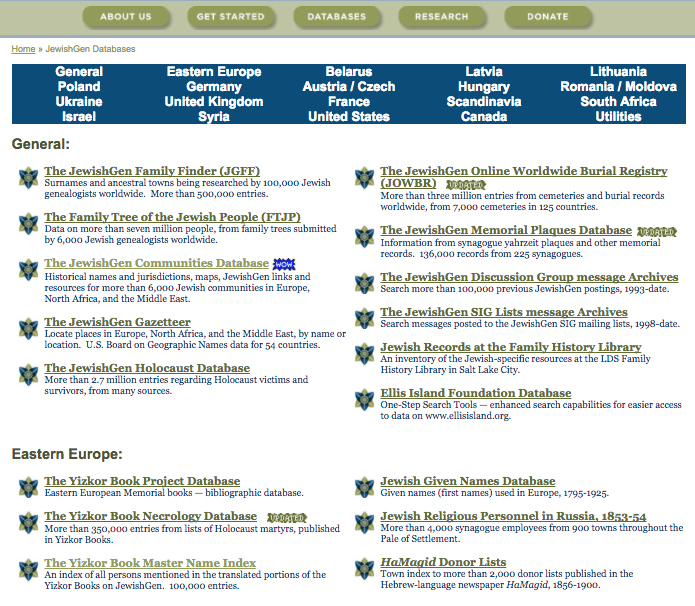Toward that end, I recently listened to a course by the Teaching Company on Discovering Your Roots. (https://www.thegreatcourses.com/courses/discovering-your-roots-an-introduction-to-genealogy.html). The author talks about the types of resources available for doing genealogical research, such as visiting libraries, courthouses, government offices and the like. But these steps assume that your family was in the United States for some time. I am envious of people, such as one of my oldest friends, last name Adams, who can trace his ancestry back to the founding father, John Adams. The author also did not deal with cases where the continuity of the family line was snuffed out in an instant.
Then there other complicating factors, such as language, geography and politics. My grandfather also spent a number of years between Poland and the United States in mandatory Palestine. And Poland wasn’t even a country until after the First World War. Up until that point, eastern Poland, where Zambrow is located, was part of the Russian Empire, and the documents are in Russian Cyrillic.
I am not the first person to begin to get interested in tracing their roots. There are people who are obsessed with finding their roots, and these people created or joined genealogical societies. Jews are no different. Most American Jews know only the basics of where their families hail from (Poland, Russia, Lithuania, etc.) But in the 1970s and 1980s, a number of second-generation American Jews began forming genealogical organizations to support and enable those doing research into their families’ past. The first American Jewish genealogical organization, the Jewish Genealogical Society of New York, whose annual meeting I recently attended, was founded in 1977. (see https://www.jgsny.org) According to its website, there are now more than 80 Jewish genealogical organizations worldwide. Each year, there is a conference of the organizations, under the auspices of the International Association of Jewish Genealogical Societies (IAJGS) which, this year, happens to be taking place in Warsaw in the summer of 2018. (http://www.iajgs.org/blog/iajgs-2018-in-warsaw/) I hope to attend.
Then there is JewishGen, founded in 1987. JewishGen is a clearinghouse of “databases, resources and research tools.” It has a collection of translated Yizkor Books that are searchable by name. As described by its website, JewishGen hosts more than 20 million records, and provided a myriad of resources and search tools designed to assist those in researching their Jewish ancestry.” (https://www.jewishgen.org/databases/) Here is what the site looks like:
Doing genealogical research has always been a painstaking activity. It attracts people who like puzzles. It probably also appeals to obsessive types, frustrated (or actual) historians such as I, who get excited by the discovery of a long neglected document.
One such person whom I spoke with recently is Steven Zedeck, who just so happens also descends from Zembrovers (people from Zambrow). About 20 years ago, he and several other Jews doing research on their Polish ancestors created an organization which eventually came to be known as JRI-Poland. (JRI stands for Jewish Records Indexing). The organization is dedicated to finding, digitizing and making available for researchers all kinds of records–birth, marriage, death–from Poland, dating back to the 19th Century. You can now search for your Polish ancestors on this site and obtain digitized copies records.
For instance, here is the document (folio #29) I obtained through JRI-Poland that attests to my great grandparents marriage in Zambrow in 1897.
There is also a service available on JewishGen to get help translating these documents called Viewmate. Viewmate is a crowdsourcing service for people looking for and offering translation services for various languages such as Russian and Polish.
Mr. Zedeck explained that to find family history documents, one had to go to, of all places, one’s local Mormon Church. Yes, it seems the Mormons have been busy for over 100 years going around the world and copying all kinds of birth, marriage and death certificates. And why, you might ask?
According to a Mormon Website,
Latter-day Saints believe that the eternal joining of families is possible through sacred sealing ceremonies that take place in temples. These temple rites may also be performed by proxy for those who have died.
Consequently, for Mormons, genealogical research or family history is the essential forerunner for temple work for the dead. In Latter-day Saint belief, the dead have the choice to accept or reject the services performed for them.
Since 1894, The Church of Jesus Christ of Latter-day Saints has dedicated time and resources to collecting and sharing records of genealogical importance. Due to cooperation from government archives, churches, and libraries, the Church has created the largest collection of family records in the world, with information on more than 3 billion deceased people. This effort was originally facilitated through the Genealogical Society of Utah and now through FamilySearch, a non-profit organization sponsored by the Church.
FamilySearch provides access to information from 100 countries, including birth, marriage, and death records, censuses, probates and wills, land records, and more. These records are made available to the public free of charge through the FamilySearch.org website, the world-renowned Family History Library in Salt Lake City, and through a network of 4,600 local family history centers in 126 countries.
It may just be worth it for me to take a trip down to the Mormon Church in New York. In the meantime, I will content myself to sitting in front of my computer, typing in searches, and trying to put together the pieces of my past.




